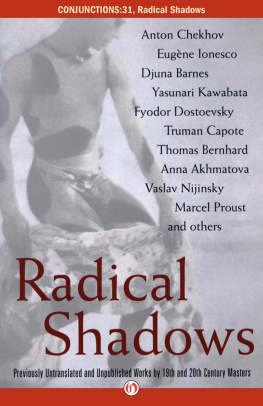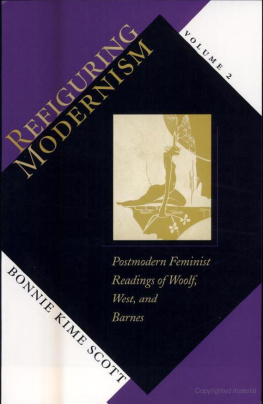VIVID AND REPULSIVE AS THE TRUTH
The Early Works of Djuna Barnes
Djuna Barnes
Edited and with an Introduction by
Katharine Maller
DOVER PUBLICATIONS, INC.
MINEOLA, NEW YORK
Copyright
Copyright 2016 by Dover Publications, Inc.
Introduction copyright 2016 by Katharine Maller
All rights reserved.
Bibliographical Note
This Dover edition, first published in 2016, is a new compilation of short works and illustrations by Djuna Barnes, reprinted from authoritative sources. Katharine Maller has made the selection and has written an Introduction and a Note on the Sources specially for this edition.
Library of Congress Cataloging-in-Publication Data
Names: Barnes, Djuna, author. | Maller, Katharine, editor, writer of introduction.
Title: Vivid and repulsive as the truth : the early works of Djuna Barnes / Djuna Barnes; edited and with an introduction by Katharine Maller.
Description: Mineola, New York : Dover Publications, 2016.
Identifiers: LCCN 2016011698 | ISBN 9780486805597 (paperback) | ISBN 048680559X
Subjects: | BISAC: LITERARY COLLECTIONS / General.
Classification: LCC PS3503.A614 A6 2016 | DDC 818/.5209dc23 LC record available at https://lccn.loc.gov/2016011698
Manufactured in the United States by RR Donnelley
80559X01 2016
www.doverpublications.com
Introduction
I FIRST CAME across Djuna Barnes quite by chance, which is the way I think shed have preferred it. I found her through the company she keptat the time, I was researching the culture and writing of Paris in the 1920s, particularly the lesbian literary scene. One thing led to another, and by a few pages into The Ladies Almanack I was so struck by her wit and art that I was determined to read everything of hers I could get my hands on. Of course, I decided this before realizing just how much Barnes wrote in her lifetime. (Im still very much in the process of reading her oeuvre.)
This volume of output was, at least in part, spurred on by necessity. Barnes was born in 1892 to an untraditional householdshe lived with her grandmother, Zadel, who was a literary giant in her own right and with whom Djuna was incredibly close; her mother, Elizabeth; her father, Wald; and her fathers mistress, Fanny. Elizabeth became increasingly frustrated by her marital situation, and, in 1912, she asked her husband to choose between her and Fanny. He chose Fanny, and Elizabeth moved to the Bronx with Djuna and her other children. This move was traumatic for Djuna, not only due to the separation from Zadel, but because the family was desperately poor. It fell to Djuna to support them financially, and, beginning in 1913, she began writing and selling articles to the various papers publishing in New York.
Barnes took to journalism quickly. Her obvious talent was complemented by her blunt charismalegend has it that she walked into the Brooklyn Daily Eagle offices in 1913 and said, I can draw and write, and youd be a fool not to hire me. Such a story seems absolutely outlandish, especially considering that she was merely twenty-one at the time, but her bravado is a constant undercurrent in her writing. It manifests itself in the ease with which she interviews some of the greatest talents of her time, in her attraction to risky news subjects (especially her stunt journalism for The New York World), and the frankness of her prose.
By 1915, she was earning enough money to leave her familys apartment. Her move to Washington Square immersed her in the Greenwich Village bohemian literary scene, and her writing blossomed. She found inspiration in the streets of Lower Manhattan, using them as the settings for her short fiction and the subjects of her articles, and she made the literary connections that set her career in motion. The same year she moved to the Village, Guido Bruno published her first book, The Book of Repulsive Women. It is in her Greenwich Village writings that we see the first echoes of the themes that would reemerge in her later significant works; namely, the grotesque nature of reality, how relationships offer respite from it, and how that respite is inconstant, temperamental, and temporary. One of the best descriptions Ive read of Barness work came from Emily Coleman, who told Barnes: You make horror beautifulit is your greatest gift. That is not to say that her work is gloomy, or pessimistic. When her pieces deal with the grotesque, they rely on juxtapositionsthe beautiful moments in these works shine brightly, made valuable in contrast to their opposites. And however dismal the subject matter, Barness wit is ever-present.
These early works are especially intriguing because they are very much of their place and time. The articles, interviews, and stories of this collection are set in a recognizable world; they are grounded in their settings, they are concrete, and they are often raw. Barnes builds a sense of space through her charactersthe teens years of 1900 in New York have never felt so textured and tangible. Its a world thats long gone, but Djuna has preserved it more charmingly than a history or photo book ever could. This charm is due in part to Barness subjective writing style. Barnes is an active and constant presence in her journalism, and she invents much of her subjects dialogue, imbuing it with a literary wither literary wit.
There are, of course, arguments to be made against these works. Barnes herself was loathe to see them republished and dismissed them as juvenilia because she essentially wrote them to survive. With all due respect to Barness wishes, I believe it would be a shame for the bulk of this work to fall into obscurity. However, being of their time includes the many unsavory views of their time: crude racism, xenophobia, and sexism. While Barnes was shockingly progressive with regard to social issues such as sexuality, in some of her articles she expressed views that, in my opinion, belong firmly in the past. I have not created a revisionist history of her workindeed, some of the pieces included in this collection espouse views with which Im still uncomfortable. That discomfort is important; however, some articles quote language and viewpoints that I find not only uncomfortable, but reprehensible. Rather than edit the language of these pieces, Ive chosen to exclude them entirely.
In compiling this book, I strove to collect a representative sampling of these early works. I have included work from as many publications as I could accessthe note on the sources supplement delves further into the history of these myriad publications, offering information that illuminates not only the publishing world of the early twentieth century, but also demonstrating how adaptable and prolific Barnes was as an author. In selecting an eclectic mix of journalism, fiction, and poetry, it is my hope that the reader will come away not only entertainedfor these works are, above all, a pleasure to readbut with a deeper understanding of and appreciation for Djuna Barnes, the most famous unknown author in the world.
Acknowledgments
I AM DEEPLY indebted to Douglas Messerli in the compilation of this workas the preeminent Djuna Barnes scholar, he has laid the groundwork in bringing Barness work back into publication, and his bibliography of her works was an invaluable resource for this project.
Id also like to thank John Grafton, Joann Schwendemann, Pete Lenz, Drew Ford, M.C. Waldrep, Frank Fontana, Laura and Bob Maller, and Brian Cahill Moledo for their support and encouragement.
Katharine Maller
A Note on the Sources
DJUNA BARNESS NEW York is a world that no longer existsa world of Greenwich Village bohemians and unbelievable artistic production. The publications that featured Barness work showcased it alongside the eras foremost modernist writers, and in doing so established her as one of their rank. As most of these publications ceased production decades ago, I compiled a list of the sources with a bit of information about each, so that you might better understand the context in which Barness work appeared.
Next page







